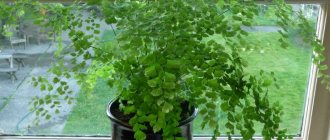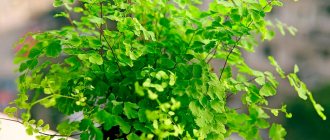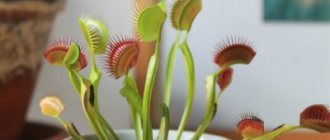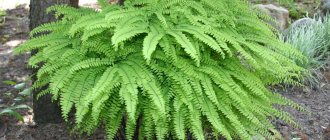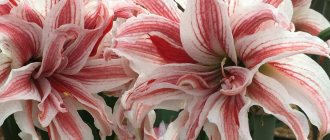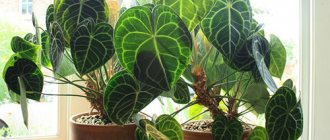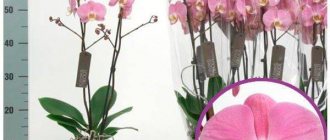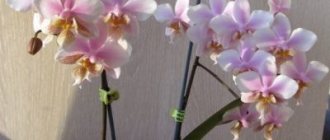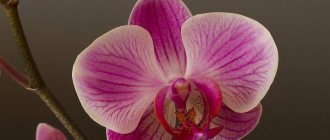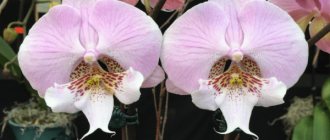Maidenhair, or lady's hair, is the most graceful of ferns. Without exception, all representatives of this family are distinguished by their sophisticated beauty. But the adiantum is special. He is the best among equals. It is no coincidence that this fragile plant is compared to the beautiful curly hair of the goddess of love. The lush green hairstyle is held on by dark elastic petioles and sways picturesquely at the slightest air movement. You need to take care of your adiantum just as diligently as you take care of your hair. It is moisturized, washed, nourished and cut. But lady's hair has a significant advantage over other indoor plants; when grown at home, it does not need a lot of light to feel good. With proper care, the maidenhair fern will delight you for many years with its lush and patterned greenery, which will decorate even northern windows and dark corners of your home.
Adiantum - the most graceful fern
Adiantum is a bright representative of the glorious and numerous family of ferns. In the wild, it usually lives in the lower tiers of tropical and subtropical mountain forests. But the adiantum has also mastered the mild temperate climate. It tolerates slight frosts, but in cold weather the above-ground part of the fern dies off. It can be seen in the North Caucasus, Crimea, Mediterranean, European countries, America and the mountains of Africa. Adiantum has a predilection for mountainous terrain, shady and damp places. It is able to grow on rocky soil and does not need much soil. This fern settles on the banks of rivers, near waterfalls, and in rock crevices.
Adiantum prefers mountainous terrain, shade and humidity
More than two hundred years ago, the maidenhair fern moved into human habitation. Flower growers immediately appreciated the grace of its patterned leaves (they are called fronds). However, the delicate plant, sensitive to air quality, was not then able to fully adapt to homes with stove heating. Therefore, adiantum, like other ferns, was grown only in rich families who had greenhouses and winter gardens. Central heating improved the atmosphere in apartments, and maidenhairs decorated window sills in a variety of houses. But a new problem has appeared: too dry air in heated apartments is harmful to the health of ferns. Now there are different ways to make the humidity higher. This means that now fans of the wonderful greenery of adiantum can grow this exotic plant without much hassle. Moreover, according to doctors and cosmetologists, humidified air is also beneficial for humans.
The name maidenhair comes from the Greek expression a diant, which means “not to wet.” The surface of the leaves of this fern seems to be covered with a film. Water flows off them without stopping, that is, without wetting them.
Adiantum has light leaves on dark petioles
Adiantum is the most elegant among ferns that are grown at home. He received the name Venus Hair. But this is the name of only one species. There are other, less well-known, but equally picturesque varieties. Adiantum differs from the classic fern, with a rosette of long drooping leaves in an arch, by special petioles, black and reminiscent of thin wire. Apparently, these petioles inspired the comparison with hair. Why the hair of Venus? Because this goddess, born from sea foam, is the embodiment of love and beauty. Who else but her could wear such an elegant hairstyle? After all, the hair-stalks are decorated with soft green small wavy leaves, so similar to curly curls. At the edge of each leaf there is a sorus, this is a kind of pocket in which fern spores ripen.
Along the edges of the leaves there are “pockets” with spores
There are several legends about the origin of adiantum. A beautiful young girl fell from a cliff. A waterfall broke through in this place, and her hair became a fern. Another legend says that Venus, the goddess of love, cut her hair and dropped a strand, and from it a maidenhair tree grew. That's why it was called Venus hair.
Adiantum is not the tallest fern. Usually its leaves do not grow longer than 40–60 cm. But it grows very quickly. The rosette can double in size over the spring and summer. Therefore, when choosing a place for adiantum, you need to take into account its growth rate. And make sure in advance that there is room for him. The fact is that the adiantum has a slight whim. He is constant and does not like to be moved from place to place. Due to stress, a lush head of foliage can lose its decorative effect and even dry out. So it is better to immediately assign it to a permanent place.
Try to immediately determine a permanent place for the adiantum; it does not like moving
Adiantum is mentioned in the works of Pliny the Elder, an ancient Roman writer. Ancient healers, noticing the similarity of the foliage of this fern with curls, recommended the plant as a remedy for hair. Some peoples of the Caucasus still rinse their hair with adiantum infusion; it is believed that it adds shine. In China, a decoction of the leaves is used in the treatment of alcohol and tobacco addiction. Adiantum will force you to adopt healthy habits. It is like a typical, but also especially delicate fern, very sensitive to dirty air. Therefore, it does not tolerate smokers. Tobacco or other smoke is harmful to adiantum.
The delicate greenery of the adiantum will require some attention from the gardener. But by creating this fern the conditions to which it is accustomed, by indulging its whims, you will get wonderful patterned emerald green fronds. They will decorate such corners of your home where no plant would agree to grow. Adiantum will not require artificial lighting in winter. He is content with partial shade in the back of the room or near the north window. Adiantum is beautiful just on the windowsill, on a high stand or in a hanging pot.
Most varieties of adiantum can be grown in hanging baskets or plant pots
Plant varieties
There are about two thousand ferns in nature. Adiantum has received recognition as the most delicate and refined. Some of its varieties are especially loved by gardeners for their original greenery. The most striking representative is the adiantum of Venus hair. Sometimes this name is extended to all varieties of adiantum.
- Adiantum Venus hair (capillus-veneris) under natural conditions grows on the rocky banks of rivers and lakes in the mountains. Its leaves extend up to 25 cm. They are asymmetrical and highly feathery. On dark shiny petioles there are small (2–3 cm) fan-shaped leaves. The contrast of light greenery and almost black petioles looks very impressive. Spores ripen on the edges of the leaves from May to October. But at home, the plant reproduces better by dividing the rhizome.
- Adiantum macrophyllum is a fern of American origin. There it grows near roads, near drainage ditches. Its pointed leaves, 30 to 50 cm long, are unusually colored. Young shoots of adiantum are large-leaved reddish-pink in color and only turn green over time.
- Maidenhair (pedatum) is the most cold-resistant fern. It is grown in open ground in the south of Russia and even in central Russia. On flexible dark petioles about 60 cm long, small leaves, dissected at one edge, are located like an umbrella. The maidenhair bush is usually semicircular in shape. This variety is most convenient for growing at home; it is not as capricious as other adiantums.
- A curious subspecies of the maidenhair adiantum is aleuticum. This is a miniature, neat plant (only about 30 cm). Pale green serrated leaves are symmetrically arranged on dark brown petioles.
- Adiantum finely pubescent (fine-haired, hispidulum) is common in the mountains of Africa, Australia, and India. On brown petioles up to 35 cm long there are small diamond-shaped leaves. They are pubescent, with teeth along the edge. The sori are arranged tightly. Feels good in room conditions.
- Tender adiantum (tenerum) grows in the Antilles, in the tropics of America. Petioles are glossy black (30 cm long). The leaves are delicate, feathery. Very decorative. It is grown as an indoor crop.
- Adiantum venustum is native to Nepal and India. It has red-brown petioles and elongated leaves of a rich green color. The plant is compact up to 40 cm. It is often grown as a hanging plant.
- Adiantum reniforme is the most unusual fern in this family. On long flexible petioles there are semicircular, horseshoe-like leaves. In the wild, adiantum reniform is common in the Canaries. There are varieties up to 20 cm tall, and there are crumbs 5–10 cm tall.
- Adiantum Ruddy (raddianum) is a native of the South American tropics. It has long (45 cm) creeping leaves with characteristic toothed segments, each of which is no more than a centimeter. Petioles are dark brown or almost black. Adiantum Ruddy is popular in indoor floriculture; several varieties are cultivated at home.
- Adiantum Raddi Fragrance (raddianum Fragrantissimum) is a rapidly growing fern. The bush grows about half a meter. Adiantum Fragrance has curly leaves; they are not very densely located on gray-brown petioles.
- Chilean adiantum (Chilense) is a small fern (no more than 40 cm), grows on mountain slopes, and tolerates short-term drought well. The round-toothed leaves on the petioles are arranged tightly, overlapping the arches of each other.
- Ethiopian maidenhair (aethiopicum) is common in Africa, Australia and New Zealand. This fern is distinguished by its petioles. They are black below and purple above. The leaf segments are shaped like a wide wedge with a rounded edge and are arranged very sparsely.
Useful qualities
The beneficial properties of the medicinal plant have been known since ancient times. Pharmacopoeial monographs of Western European countries, which regulate the quality requirements for medicines, include fern leaves in the description of recipes. The water infusion has an antibacterial effect. Powder, decoction, syrup, alcohol infusion as part of preparations or when used independently have the following properties:
- emollient;
- antipyretic;
- expectorant.
Diseases of the bladder, liver, stomach, spleen, respiratory infections are only a small part of the diseases for which it is advisable to use medicines with adiantum, prepared according to folk recipes. The use of leaves is described in ancient Indian Ayurvedic recipes. They are ground to a paste-like state and prescribed as a wound-healing agent. The juice in combination with honey is used for stomach pain and respiratory infections. Brewed leaves are a good general tonic.
Doctors of medieval Armenia widely used the medicinal properties of ferns. A leaf decoction was used to cure jaundice, urolithiasis, prolonged fever, and back pain. The juice was used topically in the form of lotions, compresses for non-healing ulcers, and for detoxification after an attack by rabid dogs. Scrofula (exudative diathesis) and eye diseases were successfully treated with ointments. Chinese healers prepared a decoction of fern greens to get rid of addiction to tobacco and alcohol.
The Roman writer Pliny the Elder described in detail the adiantum officinalis in his work “Natural History”. It was he who compared the openwork leaves with girlish curls. Since then, fern has been recommended to improve hair condition. Caucasian women still rinse their hair with its decoction for strength and shine.
Conditions for Venus hair
All the beauty of the adiantum is the beautiful fronds with the contrast of dark, slightly wavy petioles and soft green small leaves. But Venus's hair is fragile. Fronds will not grow well if there is not enough space for the maidenhair. Do not place the fern in a close group of flowers, give it more space to develop, and then its beauty will remain for many years.
Adiantum is not very capricious, but still requires certain conditions, without which it will not be able to show all its beauty. In order for the green hair to be lush and bright, provide it with high air humidity and warmth, diffused light, without hot sun, do not overheat the plant and do not allow the soil to dry out. The best place for adiantum is an eastern or northern window. You can place it in the west and even on the south side, but then move the plant three meters deep into the room.
Table: conditions for adiantum
| Spring | Lighting: partial shade, diffused light. Possibly some sun in the morning and evening. Humidity is high 60–70 percent or more. Regularly spray the adiantum with lukewarm water, use other methods of moisturizing (more on this below). Provide fresh air, ventilate the room. The temperature is moderate, about 20–25 degrees. |
| Summer | Lighting - partial shade, diffused light, a small amount of sun is permissible only in the morning and evening hours. Shade the plant at midday. Humidity is high 60–70 percent or more. Spray the plant often, give it a shower, but cover the soil with film. The temperature is moderate, preferably up to 25 degrees, maximum 27. Heat is difficult to tolerate. On hot days, ventilate the room, but keep it away from drafts. Walking is only possible in places protected from the wind. It can damage delicate leaves. And keep in mind that adiantum does not like changing places. |
| Autumn | Diffused lighting, partial shade. Humidity is high. Temperature is moderate. |
| Winter | Lighting - partial shade, diffused light, possibly a small amount of sun. No additional lighting is needed. Humidity is high. Moisten the leaves and air. Place the maidenhair tree away from heating devices and cover it with a protective screen. Temperature is moderately cool + 15–22 degrees. It cannot stand below +10 degrees. Protect the adiantum from drafts. |
How to humidify the air for delicate adiantum
In nature, adiantum grows along the banks of reservoirs, and it especially likes waterfalls. The plant needs high humidity all year round - this is perhaps the main difficulty for the gardener. Dry air is detrimental to the delicate green hair of Venus. There are simple ways to create a tropical atmosphere at home.
- The apartment also has its own waterfalls - taps. Place the adiantum in a room where the air is especially humid. For example, in the kitchen (only at a distance from the hob and oven) or the bathroom, if there is a window there.
- Give the adiantum an indoor fountain. This way you will kill two birds with one stone: you will make the composition with ferns more decorative and humidify the air.
- Place an electric humidifier next to the adiantum.
- Spray the fern with the smallest spray bottle. Use lukewarm water. In winter, spray in the first half of the day so that the leaves have time to dry before evening. In summer, do not spray at midday; droplets of water in the sun can cause burns.
- Place the adiantum next to the same moisture-loving plants. Then after spraying the moisture will remain longer.
- Have a maiden shower at least once a week. During water procedures, especially in the cold season, cover the ground with a film or bag to prevent waterlogging.
- Place the maidenhair pot on a large tray with pebbles or expanded clay. Keep the litter moist at all times.
- Place the adiantum in a double pot. Place the container where the fern grows in a waterproof pot filled with sphagnum moss or peat. Moisturize them regularly. Excess moisture, evaporating from the second pot, will maintain air humidity around the adiantum.
Description of the plant
Some sources speak of adiantum as a family of the fern genus. Some publications claim that it belongs to the Pteris family .
Other names that you can come across are “girlish, female or Venus hair . The herbaceous plant is quite widely distributed geographically throughout the world. Often grows near bodies of water or in other places with high humidity . An excellent place for its habitat is well-drained tropical soils. Subtropical, temperate climate is ideal.
Speaking about territories close to our area, adiantums can be found in the Caucasus, in the mountains of Crimea, as well as Central Asia . There are two territorial centers of the species mass distribution of the plant:
- South American Andes;
- certain areas of East Asia.
Adiantum is not a very large terrestrial plant. Reaches a height of about 80 cm. It has thin creeping roots, which are covered with matte black or brown scales over the entire surface.
The leaves are located opposite. Their petiole part is dark, with a shiny surface and scales at the base. The leaf width sometimes reaches 50 cm , and the length grows up to 60 cm. The surface is smooth, strongly dissected in the form of a fan. Mostly green, but there are also bluish shades of leaf blades.
Round spores are located along the veins on the lower segment of the leaf . They are covered with a false veil with a bumpy surface. In appearance it is similar in that it is a modified continuation of the marginal part of the leaf.
The openwork and even airy foliage of the plant resembles a woman's tousled curls . This is where the common names for adiantum came from.
Replanting the maidenhair
In the wild, adiantum prefers rocky river banks and hangs out in crevices near waterfalls. It doesn't need much soil. The root of the fern is superficial, so a shallow and wide pot is suitable for growing, and the drainage layer should be impressive. The maidenhair will like the soil to be slightly acidic, nutritious and porous; it should absorb water well and dry out quickly. You can take ready-made soil for ferns, adding a little charcoal and chopped sphagnum moss to it. Or make your own potting soil. Approximate compositions:
- Add part of leaf and humus soil and half part of sand to 2 parts of peat soil.
- 3 parts each of peat and leaf soil, 2 parts of turf soil, 1 part each of humus or vermicompost and sand.
- Mix 3 parts of leaf soil with 2 parts of peat soil, 1 part of humus and coarse sand.
- Mix turf soil, peat and coarse sand in equal parts.
- In equal parts leaf soil, pine bark, humus and coconut fibers.
Young ferns need annual replanting in spring. An adult adiantum is replanted when the roots fill the entire pot. Often this procedure is combined with propagation; the overgrown root can be divided. How to transplant adiantum?
- Take a suitable container with holes, place drainage (expanded clay, pebbles, broken brick) at the bottom. Everything needs to be disinfected, at least doused with boiling water.
- Spread sterilized soil on top. Don't compact it too hard; it should remain airy.
- Remove the maidenhair from the old pot. Inspect the roots. Remove rotten, darkened and dry ones.
- Try not to damage healthy roots; there is no need to trim them. The fern root system grows slowly.
- Place the earthen ball with the adiantum in a new pot. Add some soil. Lightly compact the substrate at the roots. Remember: ferns like loose soil.
- After transplanting, water the plant with warm water and spray it.
- Place the transplanted adiantum in a permanent place.
From the terrarium to the apartment: how to care for adiantum
The task of the gardener who grows adiantum is to create an environment familiar to this fern at home. Once upon a time, the delicate Venus hair was recommended to be planted only in terrariums and greenhouses. Now it is successfully raised in ordinary homes. You just need to follow simple rules for caring for adiantum.
Watering and fertilizing mode
The first rule of watering for adiantum is regularity and moderation. This fern has a negative attitude towards both drying out the soil and waterlogging it. Therefore, you should water the adiantum a little, but often. In spring and summer up to 3 times a week, in autumn less often, and in winter once every 7-10 days is enough. The main thing is that the top layer of soil should dry out between waterings.
Adiantum does not tolerate chlorinated water
Use settled, or better filtered, water for irrigation. Adiantum does not tolerate chlorinated water well. Some gardeners advise watering it with water drained from the aquarium.
During active growth, in spring and summer, the adiantum will be grateful for feeding. Food is added once every 2-3 weeks. Organic complexes are suitable for ferns or plants with decorative leaves. Reduce the dosage recommended by the manufacturer by half. Adiantum will not like mineral fertilizers. From late autumn to spring, they stop feeding the plant.
Unseen flowers
There are many beliefs about fern blossoms. This plant, living in the thicket, where it is damp and scary, caused fear, and mysterious powers were attributed to it. Our ancestors could not understand how Venus hair reproduces. Therefore, legends about the wonderful fern flower were born.
The fern blooms magically, as our ancestors believed. On the eve of the summer solstice (the holiday of Ivan Kupala), a fiery flower appears, such that one cannot look at it. It blooms for a few seconds. Then an invisible force tears off the fiery color. If a person breaks it first, he will gain power over everything.
Science has debunked the mysteries of ferns. Adiantum, like its relatives, never blooms. Instead, nature has provided another mechanism of reproduction - spores. Adriatum spores form from spring to autumn. They ripen at the tips or along the edges of leaflets in the sori. As the spores mature, they become brownish in color. They are very small, like dust. You can collect spores by cutting off a leaf and placing it on white paper.
Note to the florist
Developing at home, Venus hair can double in size in one season. This only happens with proper and careful care. Many gardeners do not need bushes that are too large, of course, unless they are growing adiantum in a greenhouse.
Alas, you have to come to terms with this, since all ferns cannot tolerate pruning. Most often, after this the plant dies. But cut off dry and yellowed branches. After this, be sure to spray the flower with warm water. Green branches cannot be cut.
So initially choose a spacious place for this flower.
Problems, diseases and pests of adiantum
Adiantum is a long-lived indoor plant. Despite the fact that this fern is a rather pampered creature. Even with care errors, attacks by parasites and illness, it can be brought back to a healthy appearance. It should be noted that insect pests rarely attack the adiantum.
Table: what to do if the leaves turn yellow, blacken, dry out or curl
| Problem | Cause | Elimination |
| The leaves turn yellow from the base. On adults there are brown spots, the leaves die off. | Too warm air, overheating. Lack of watering. Drafts. | Most likely, there is a heating radiator nearby, move the plant away from it. Protect with a screen. Follow the watering schedule. Protect from drafts. |
| Yellow leaves with brown tips, no new growth. | The air is too dry. | Humidify the air in all appropriate ways. |
| The leaves turn pale and lose color. There are burn marks on the leaf plate. | The light is too bright. Direct sun. | Move the maidenhair deeper into the room, further from the window, and shade it. |
| Pale leaves, slow growth in spring and summer. | Nutrient deficiency. | During active growth, feed the plant regularly but little by little. |
| Leaves are dying off en masse. | Dry air, overdried earthen lump. | Remove dry leaves and, if necessary, cut them down to the ground. Follow the rules of plant care (spray and water regularly). |
| The leaves are withering, but the soil is moist. | Root system rotting. | Dry the soil, adjust the watering regime. If this does not help, remove the plant from the pot, remove the rotten roots, and replant it in a new sterilized substrate. |
| The leaves curl but do not dry out. | The maidenhair is too cold, the soil is waterlogged. | Move the plant to a warmer place. Let the earthen clod dry. |
| The leaves of the adiantum have darkened and brown streaks have appeared. | Salts have accumulated in the soil. | Check the acidity of the soil, it should be slightly acidic. If the pH is below 5.5 to 6.5, replace the soil. |
| Adiantum leaves turn bronze along the edges, from the edge, and then entirely. | This is a viral disease transmitted by thrips and small flying insects. | It cannot be treated. Destroy the plant to prevent the virus from spreading. Get rid of thrips by spraying the plants with an insecticide. |
| The leaves turn pale, curl, die, and tiny insects are noticeable. | Aphid infestation. | Treat the plant with a special aphid repellent, follow the instructions for the product. |
| The leaves become discolored and dry, sometimes red-brown spots and white cobwebs appear. | Spider mite infestation. | Spray the adiantum with a systemic insecticide (fitoverm). |
| Hard brown plaques on leaves. If measures are not taken, the leaves turn yellow and become covered with a sticky coating. | Defeat by scale insects. | Remove insects with a damp cloth, treat the plant with an insecticide solution (Fitoverm). Repeat the treatment regularly until you get rid of the pest completely. |
Video: treatment of fern after damage by scale insects and care tips
How does adiantum reproduce?
Adiantum is propagated by dividing the rhizome during transplantation and by spores. Each method has positive and negative sides.
Root division
By dividing the root, only mature, or preferably old, ferns that have already begun to lose their decorative properties are propagated. Dividing the root is not such a harmless procedure. If the operation is unsuccessful you may lose the mother plant. And the survival rate of separated parts is not always high. The root of the adiantum is very sensitive, as is the whole plant.
- In spring, remove an adult adiantum bush from the pot.
- Clean the root system from the substrate.
- Using a sharpened sterile knife, cut the rhizome into pieces so that at least one leaf remains on each.
- Plant the parts in separate containers filled with light soil, sterilize it first.
- Spray the seedlings and moisten the soil.
- Place new plants in a shady and warm place.
- Apply foliar feeding through spraying.
- Adiantum seedlings develop slowly. Like adult ferns, they need high humidity, diffused light and warmth.
Young adiantums have taken root in new pots
